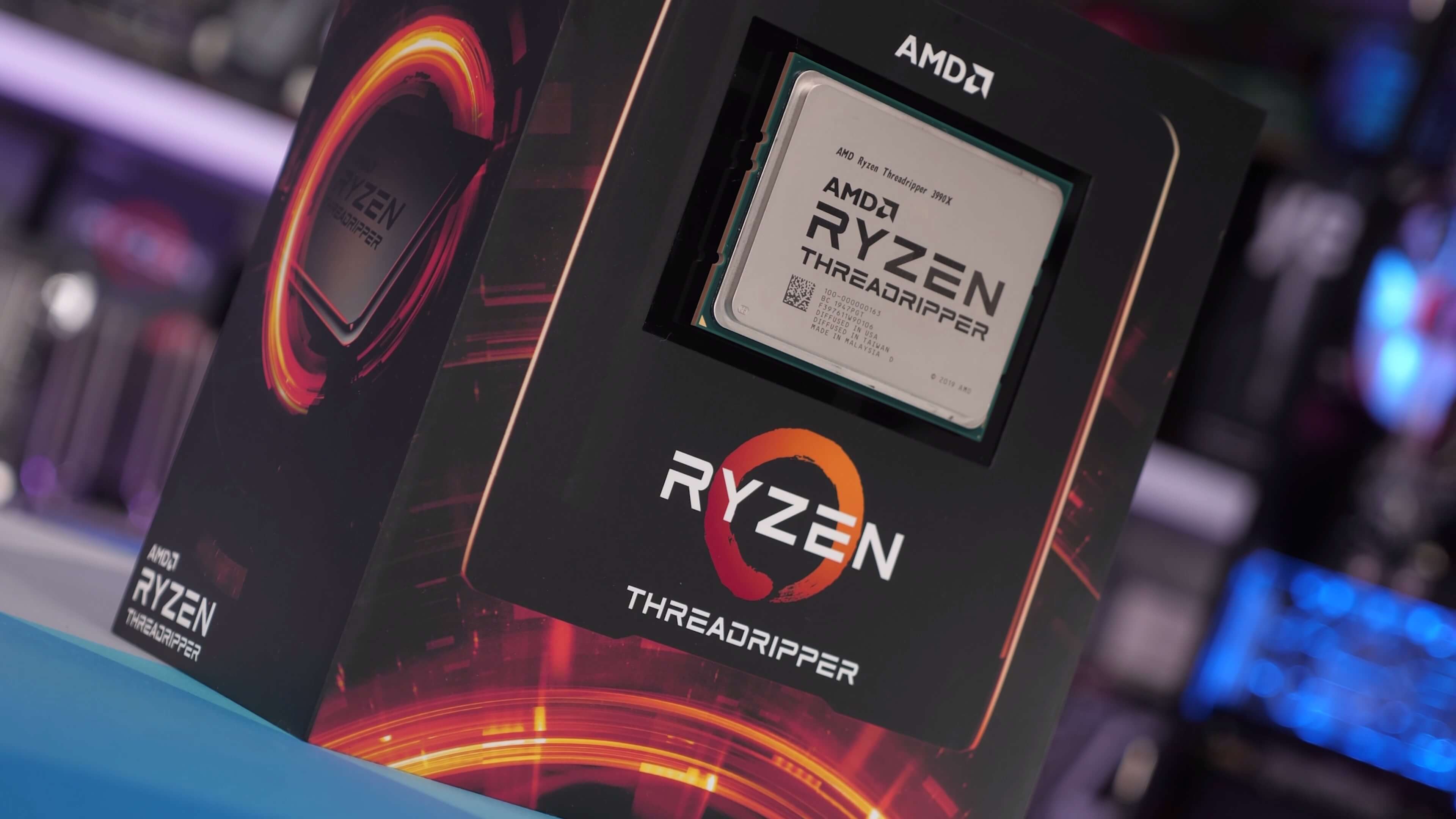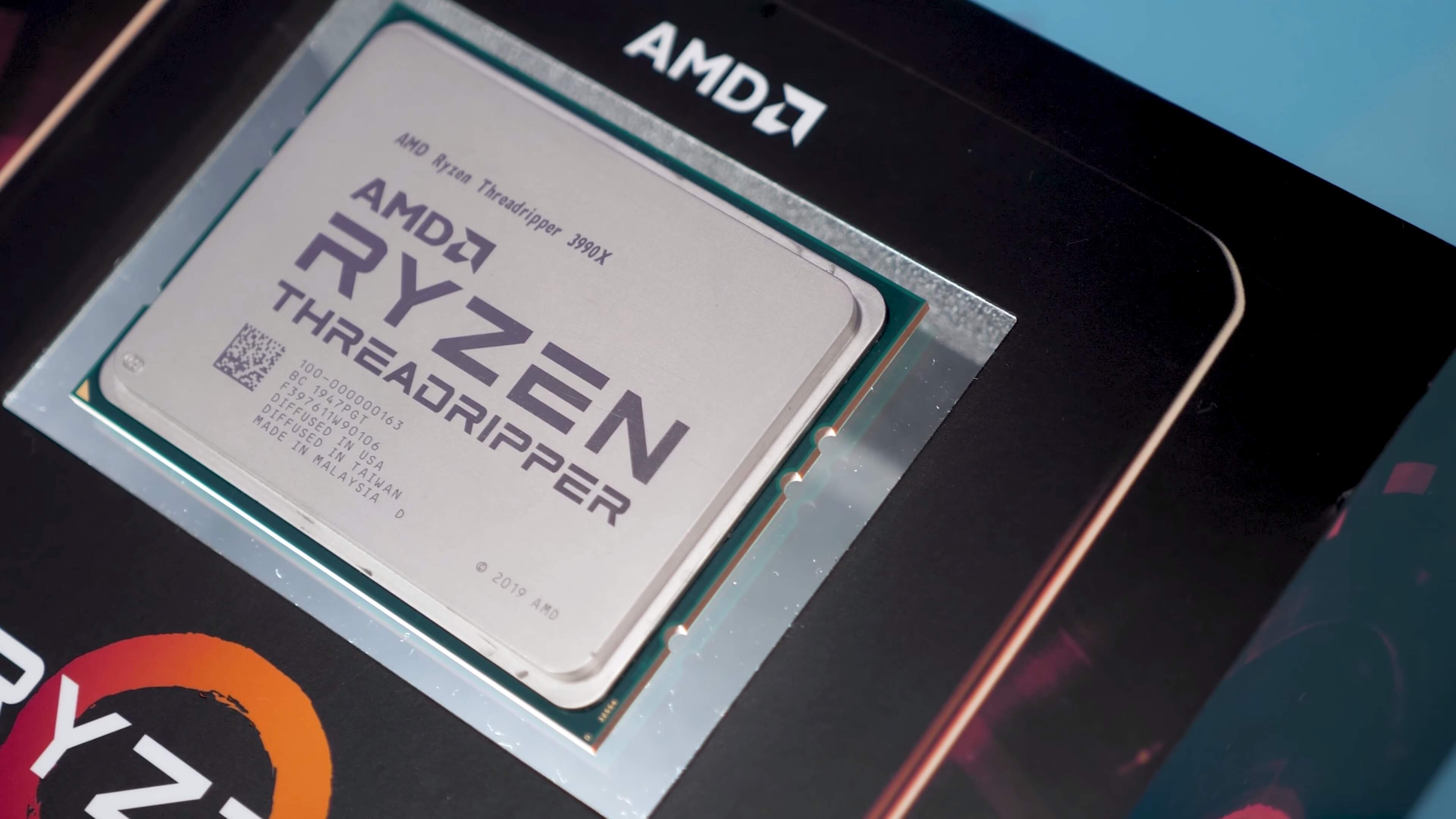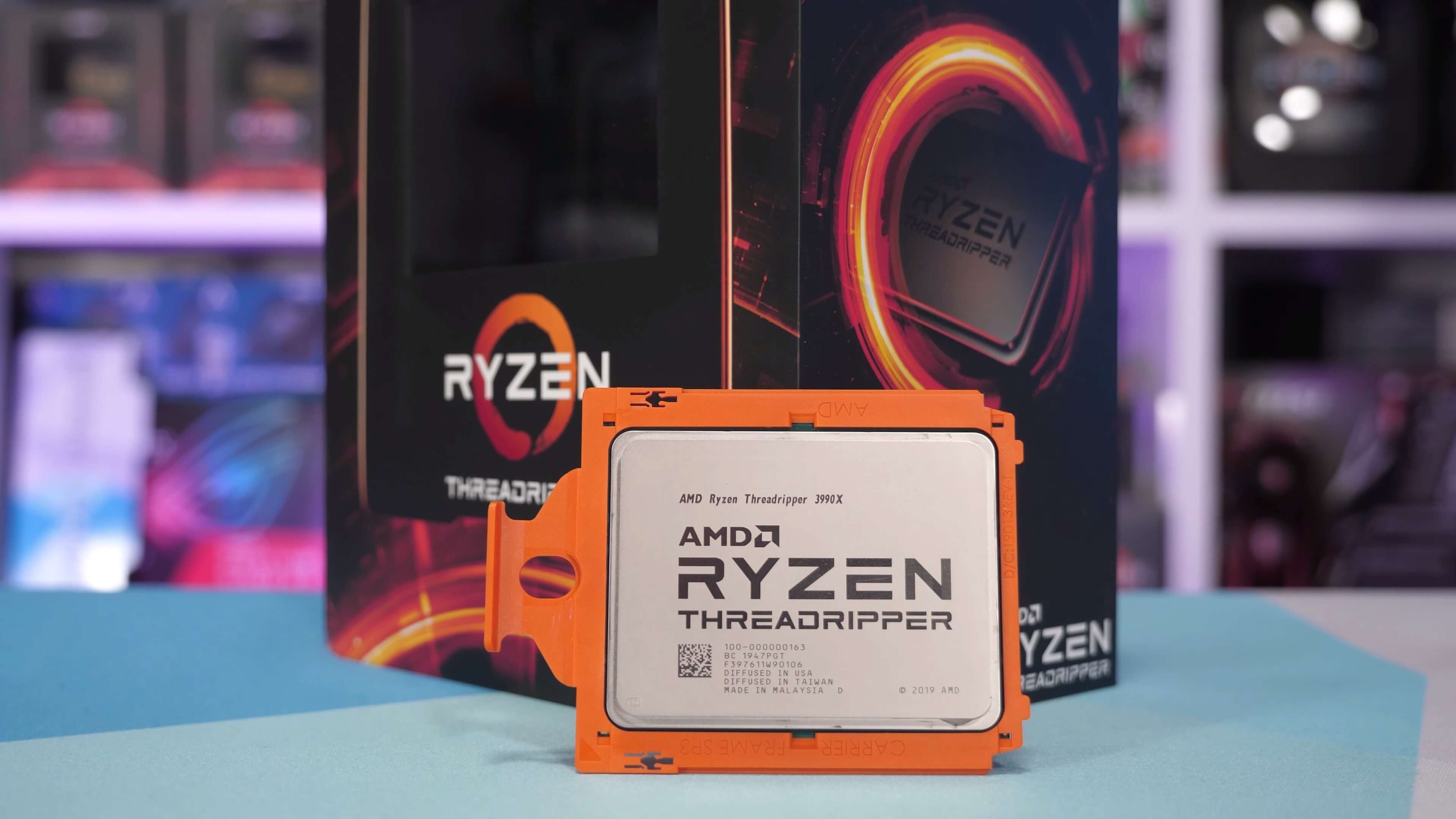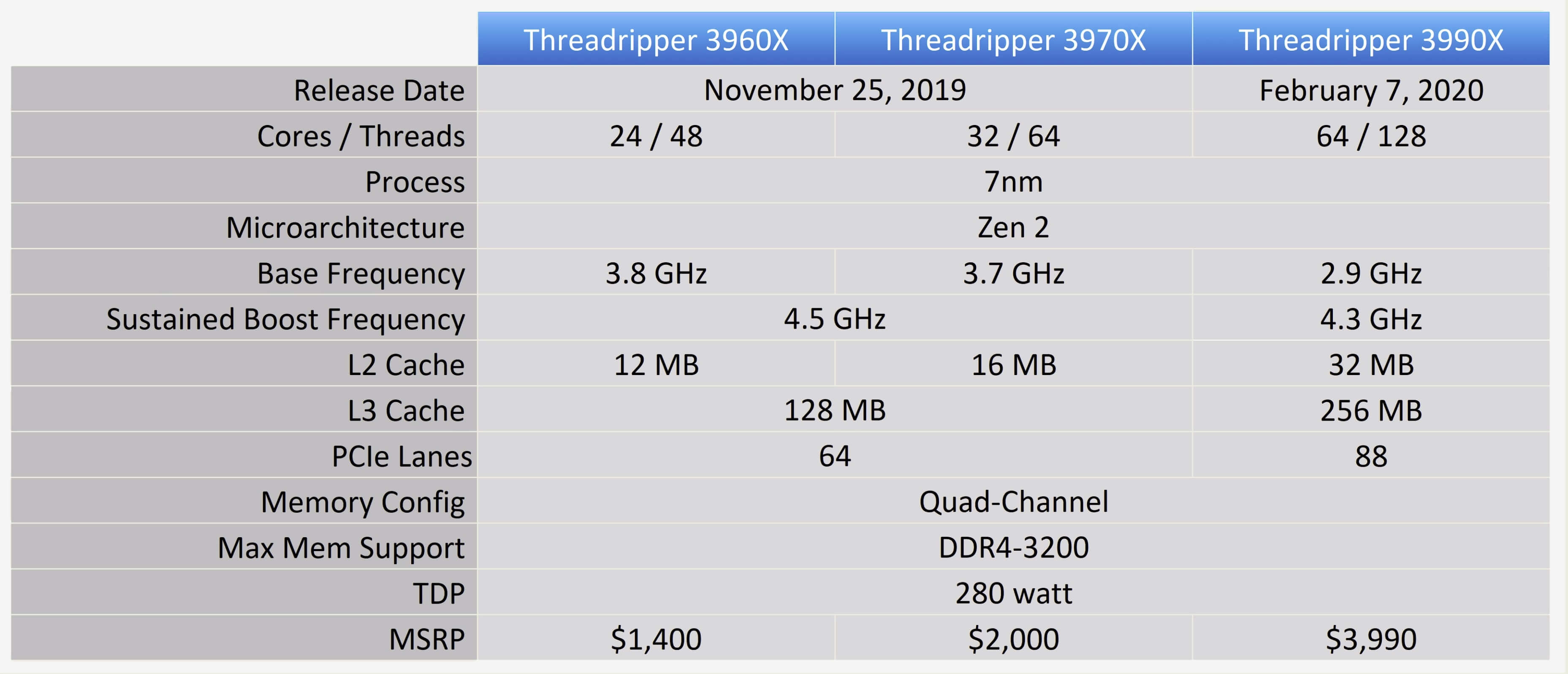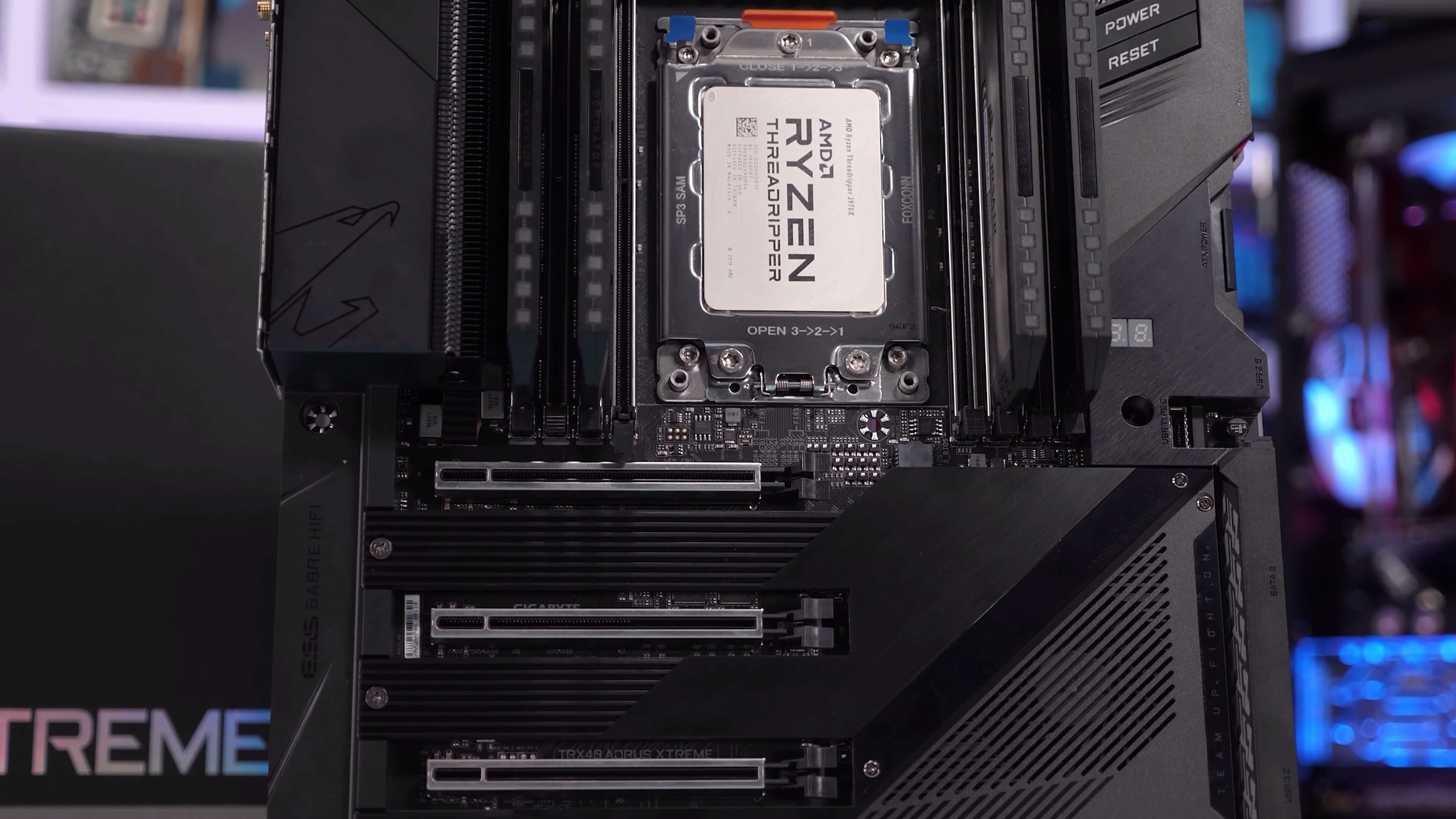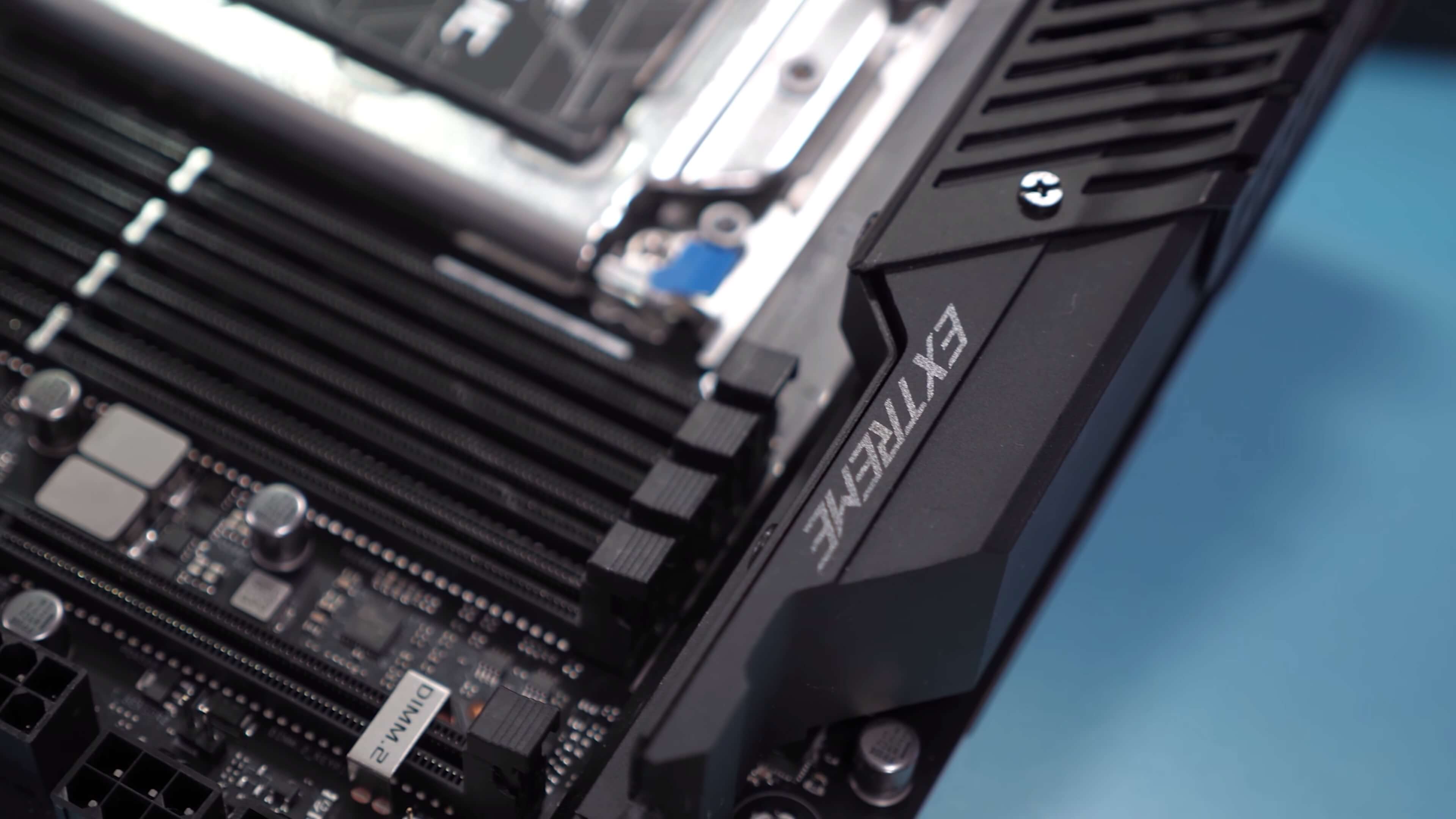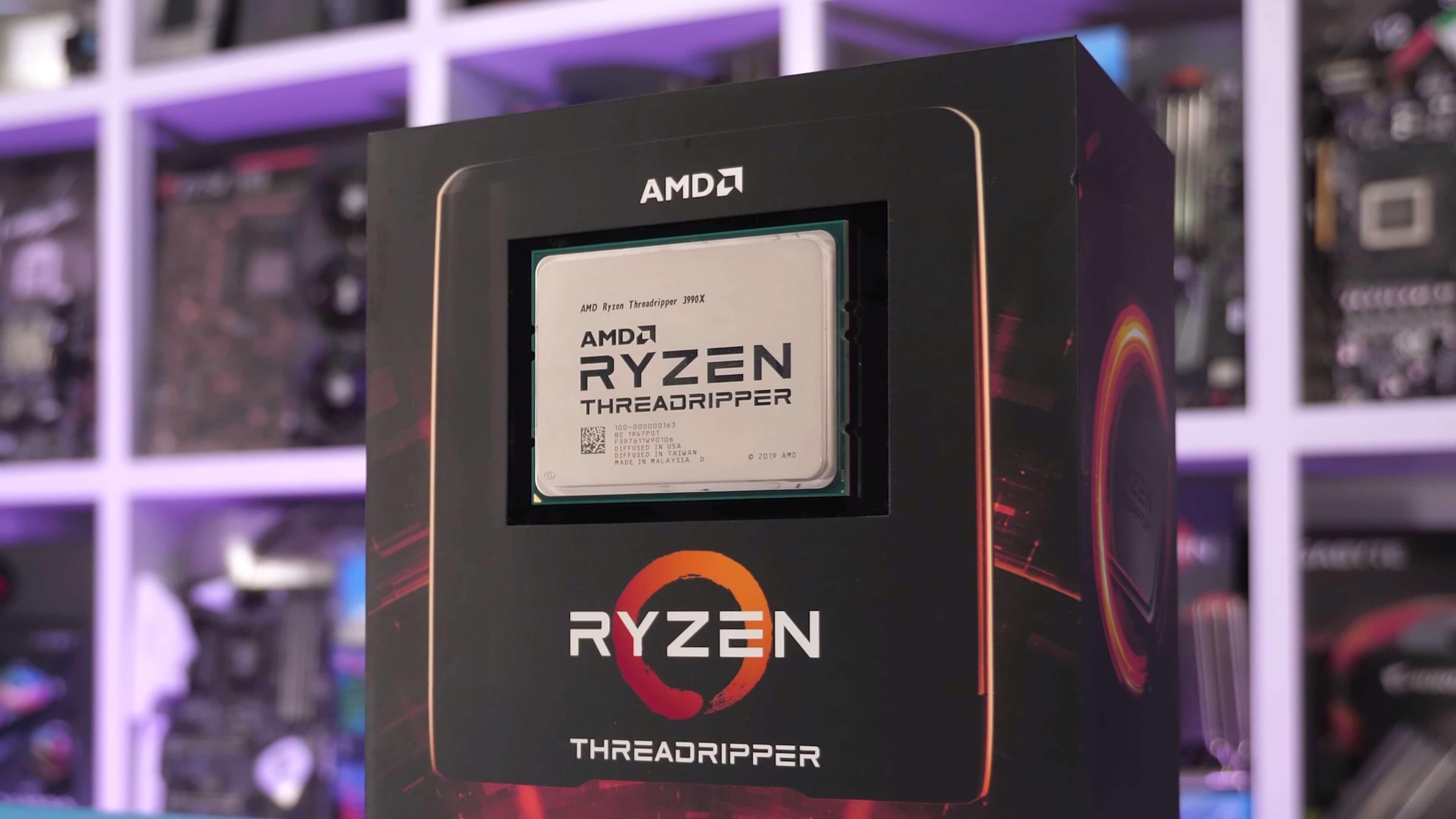Today we're looking at the most expensive desktop CPU to ever exist, and shockingly it's not from Intel. The special ocassion made us think of an Intel processor that we were quite fond of once, the Broadwell-E Core i7-6950X, which happened to be the first 10-core desktop CPU when it was released in 2016.
Full disclosure: while we very much enjoyed the 6950X, we didn't actually pay for it. Avoiding the hideous $1,700 price tag made the product a whole lot more enjoyable. For that stunning price, Intel basically tacked on two extra cores from the previous two-year-old 5960X, and jacked up the price by 75%.
By the time they released their next 10-core part all bets were off as AMD had finally got their act together and had begun kicking goals with the Zen architecture. Stiff competition from the first-gen Threadripper range saw the 10-core Core i7-7900X released at $1,000, then refreshed as the 9900X at $1,000, and refreshed once more as a $600 part in the 10900X. Many would argue that the 10-core part is overpriced at $600 and we'd generally agree.
The point we're trying to make is, a mere four years ago the best any high-end desktop platform had to offer was a $1,700 10-core processor that ran all cores at 3.4 GHz out of the box. Today AMD is releasing a CPU with over 6 times more cores, though it costs almost 2.5 times more.
Meanwhile Intel's rumored to be scrambling to release a 22-core HEDT part, but we seriously doubt they'll bother at this point. You can't even buy their current 18-core model. In theory these days Intel's offering 18 cores for $1,000, though not really since the 10980XE doesn't exist in retail. So technically if you want an 18-core Intel CPU you've got to pay around $2,000 for a 7980XE or 9980XE, whichever model you can find, so good luck with a 22-core part.
With no competition from Intel in this space, AMD can get away with charging quite the premium. To be fair though, a 64-core, 128-thread processor capable of the performance we're about to show you for $4,000 isn't as absurd as it first sounds.
Let's talk a little bit about the Threadripper 3990X before we jump into the blue bar graphs...
This is a 64-core/128-thread Zen 2-based processor. It comprises eight, 8-core chiplets or 'core complex dies', built using TSMC's 7nm process. There's also a input/output die using GlobalFoundries' 12nm process and combining the transistor count of all those dies lands us at a staggering and frankly incomprehensible 39.5 billion transistors.
The jaw dropping numbers keep coming as we dig into the specs: it packs 256 MB of L3 cache with 32 MB of L2 cache. Depending on the workload, the cores clock between 2.9 and 4.3 GHz, allowing the CPU to keep within a 280 watt TDP.
That's all very impressive, but evidently this processor isn't for everyone not only because it'll set you back a handsome $4,000, but also because it's extreme overkill for most tasks. AMD fully acknowledges that the 3990X is a special purpose processor designed for a relatively small customer base with a unique set of needs.
They say their customers for the Threadripper 3990X are predominantly professional visual effects artists and companies dabling with 8K content using various raw or lossless codecs. AMD's also verified 64-core scaling for compiling projects like Android OS or Unreal Engine, so there will no doubt be some demand for those tasks as well.
AMD believes the key to the 3990X's success will be doing something no other processor does: combine both high frequency and high core counts into a single product. This is extremely valuable for a number of industries as it ensures maximum efficiency on all levels.
For example 3D rendering tools such as Isotropix Clarisse are largely single-threaded during the setup process, before the rendering begins, so having a processor that can clock up over 4 GHz during single or lightly threaded workloads is very beneficial here. Of course a high clock speed, at least relative to other core heavy processors, is also beneficial once the rendering process begins.
There's a lot more to discuss, but we feel at this point you're really wanting to see the benchmark results, so let's get on with that and we'll talk more about the 3990X and who it's designed for a bit later in the review.
For testing the Ryzen 9 3950X, 3900X and Ryzen 7 3800X CPUs, the Gigabyte X570 Aorus Xtreme was used. Then we have the MSI X399 Creator for the 2nd-gen Threadripper 2990WX, 2950X and 2920X. For the new 3rd-gen Threadripper 3970X and 3960X, the Gigabyte TRX40 Aorus Xtreme was used. All Ryzen configurations were cooled using a custom Corsair HydroX loop with a 360mm rad.
All processors were tested using 32GB of Corsair Dominator Platinum RGB DDR4-3200 CL14 memory. We realize performance in some workloads might be higher with DDR4-3600 CL16 memory, but for an apples to apples comparison, all platforms feature the same spec memory.
On Intel's side, the Intel Cascade Lake-X Core i9-10980XE and Skylake-X Core i9-9920X were tested on the Gigabyte X299 Aorus Gaming 9, also using a Corsair HydroX loop with a 360mm rad.
Then the mainstream 8th and 9th-gen Intel Core processors were benchmarked on the Gigabyte Z390 Aorus Ultra, using the same DDR4-3200 CL14 memory, but they were cooled using the Corsair Hydro H115i RGB Platinum 280mm AIO liquid cooler. Note the Intel CPUs are not TDP restricted as that's not the out of the box experience, so we are showing the absolute best case scenario for out of the box performance. Also, please note this cooler in no way restricts performance, so we're seeing maximum performance from the Intel CPUs. Finally, the graphics card of choice was the MSI Trio GeForce RTX 2080 Ti.
Benchmarks
First up we have the Cinebench R20 scores and it's madness, as anticipated. We're looking at a score of over 24000 pts, making the 3990X a whopping 45% faster than the 3970X and 80% faster than the 3960X.
If you want to compare it with Intel's best, Threadripper is 181% faster, so 4x more expensive for almost 3x the performance in this application.
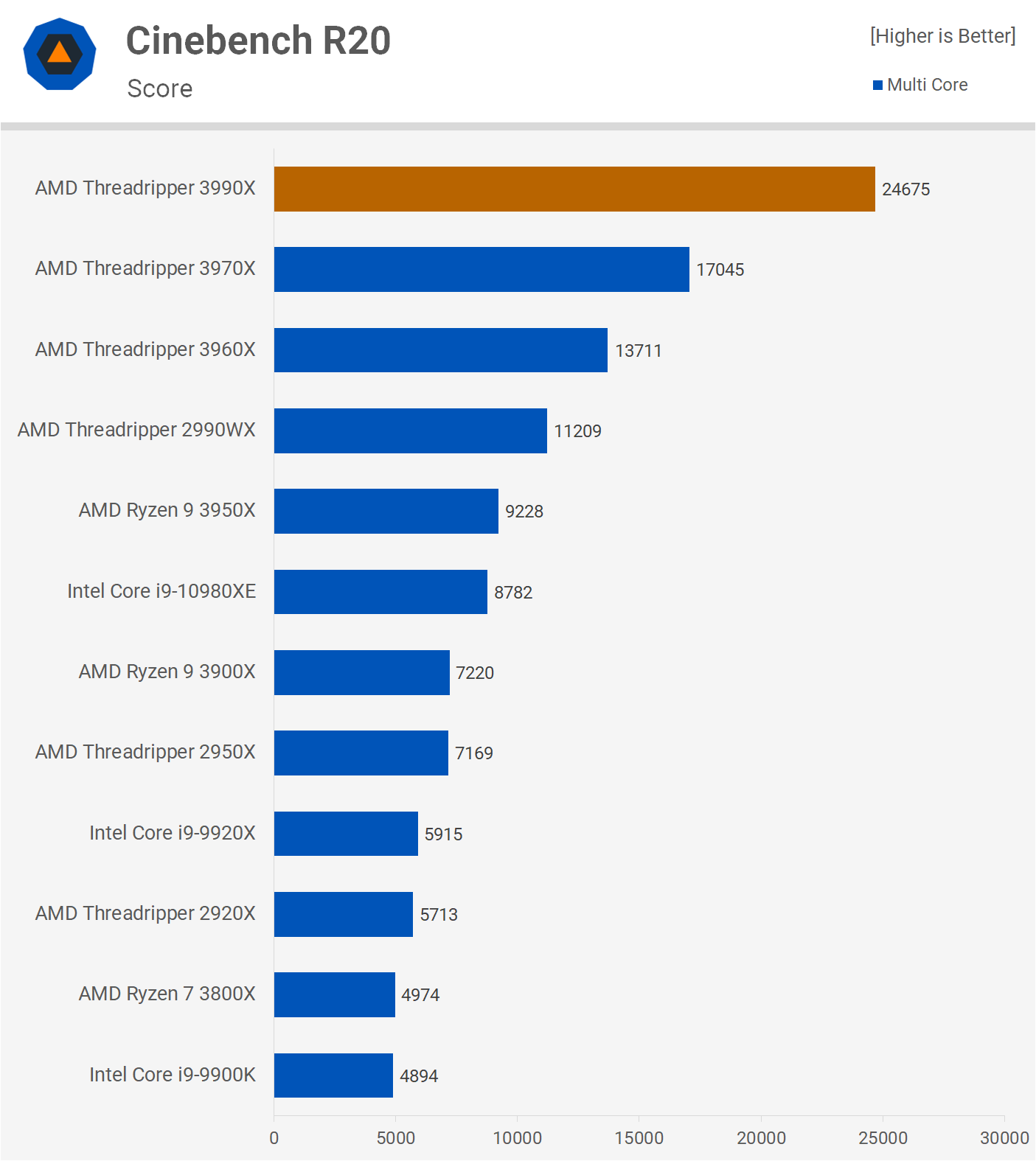

When it comes to single core performance the 3990X is still very spritely for a 64-core processor, producing a score of 494 pts which is comparable to the Core i9-10980XE, Ryzen 7 3800X and even the Core i9-9900K.

The 7-zip compression results are important because this is where the 2990WX fell apart. The 2nd-gen 32-core processor was 40% slower than the 16-core version due to the architectural design limitation that made it a poor choice for memory sensitive applications.
The I/O die featured in the 3rd-gen design overcomes this issue. We first saw this with the 3970X and AMD proves again just how scalable this design is with the 3990X. Here it was 33% faster than the 3970X and almost 100% faster than Intel's Core i9-10980XE.
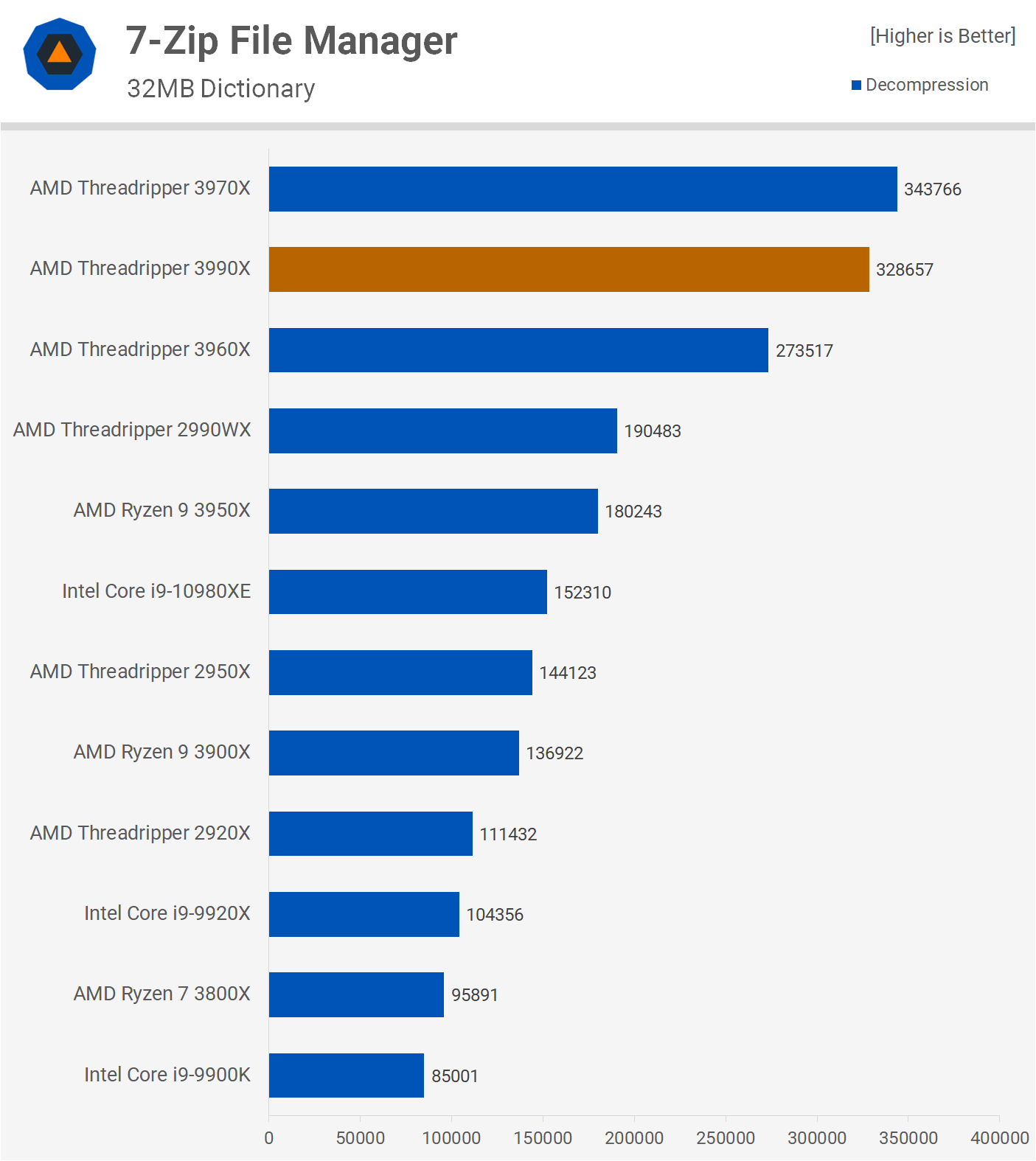
Typically it's decompression performance where Ryzen shines and while the 3990X is fast here, it is a little slower than the 3970X. This is because it's not fully utilized and this was less of an issue for the compression test which doesn't take advantage of SMT support. At most 7-zip was using 73% of the 3990X, so this gives the higher clocked 3970X a slight performance advantage.
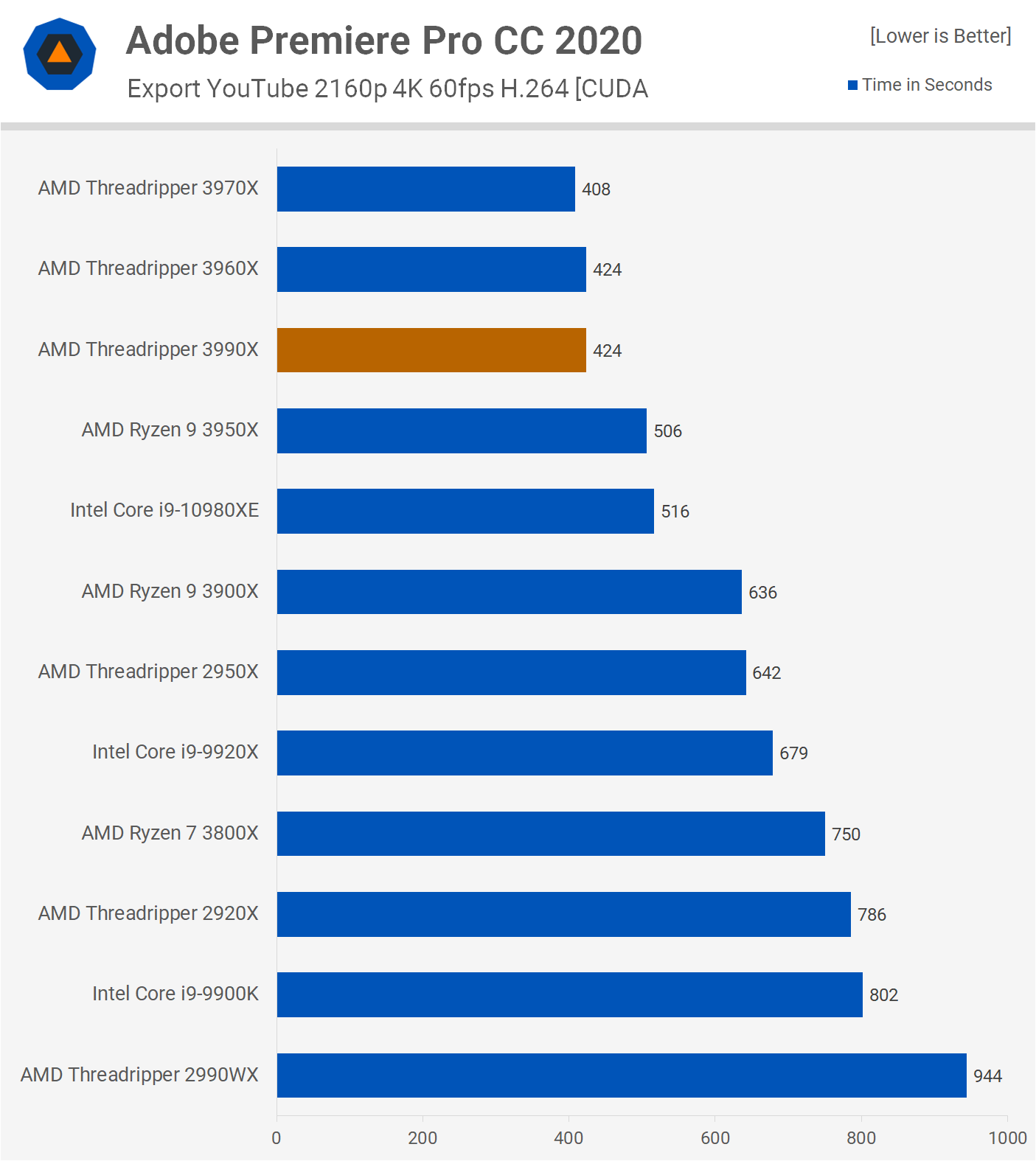
Moving on to Adobe Premiere, this is another application where the 2990WX was a complete trainwreck.
The TR 3990X hangs in there and despite very poor CPU utilization with this program, it managed to match the 3960X, taking 424 seconds, making it the second fastest desktop CPU we've tested in Premiere.
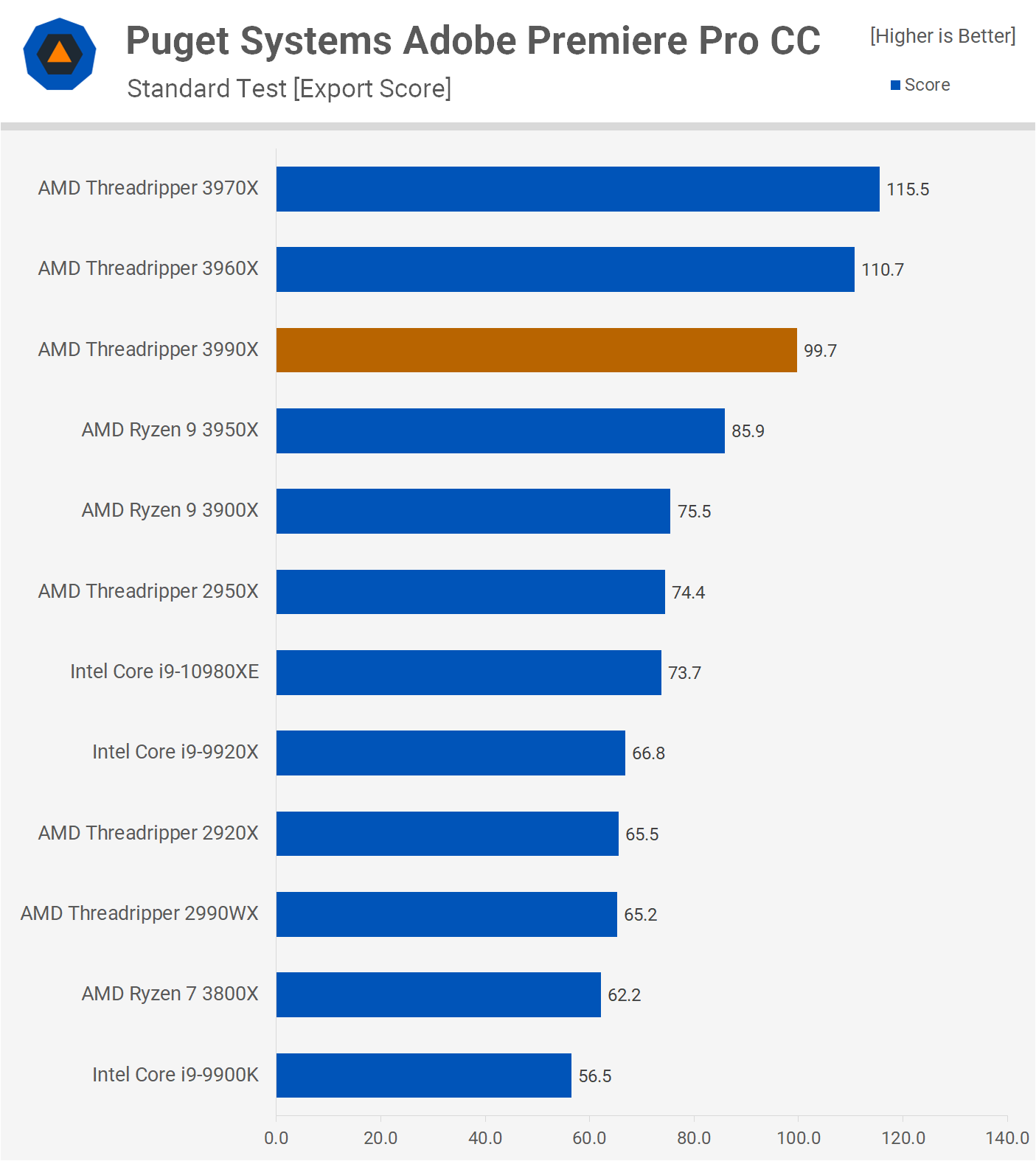
It does fair a little worse in the Puget Systems export test, where the 3970X was 16% faster, so obviously the 3990X isn't a great value choice for Premiere users. But if you're primarily using it with applications that do get a big performance boost from the 64 cores, it's good to know the chip can still handle Premiere with aplomb unlike the older 2990WX.
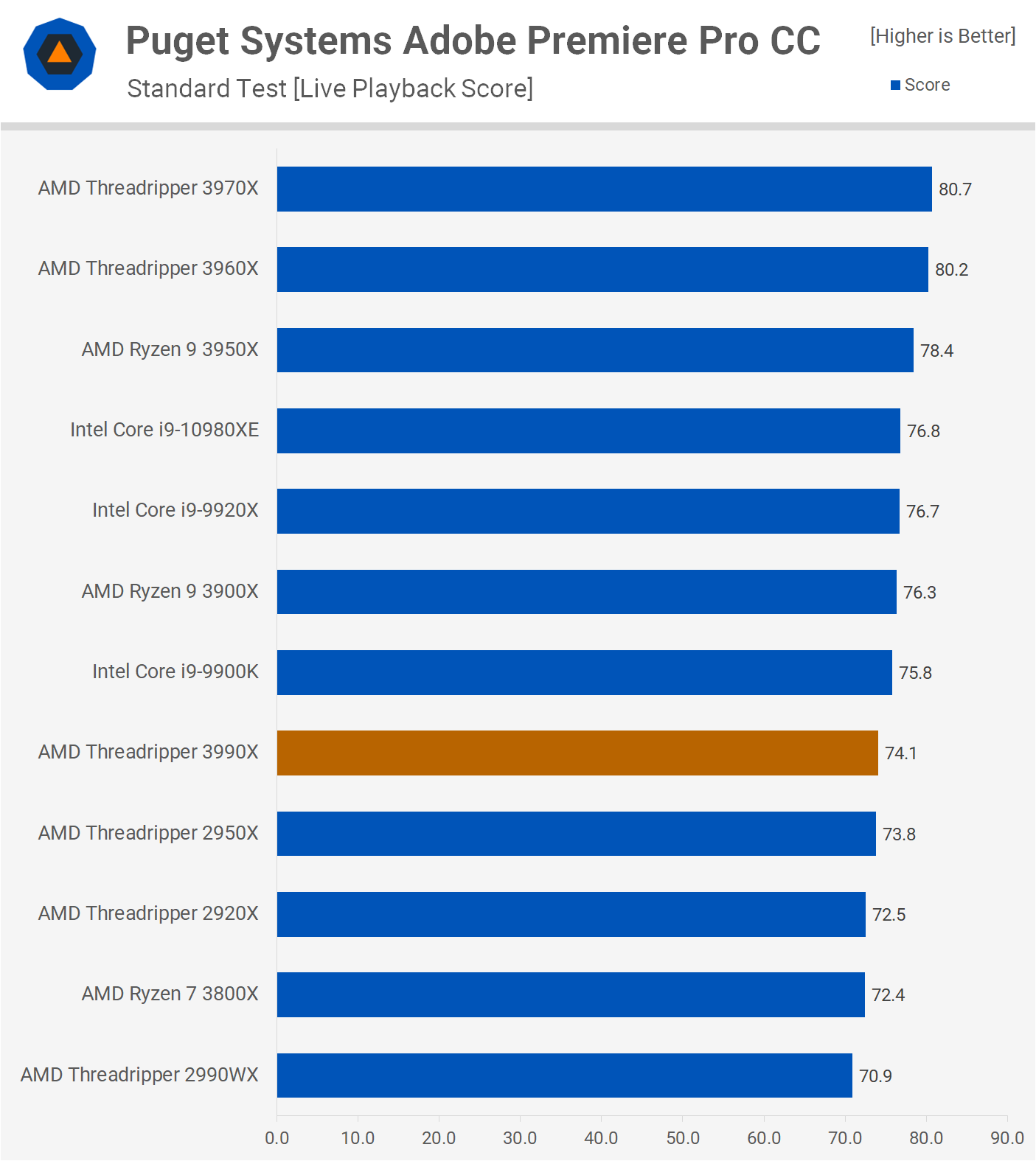
Playback performance was solid. Again, it's a little down on the 24 and 32-core models, but nothing alarming here.
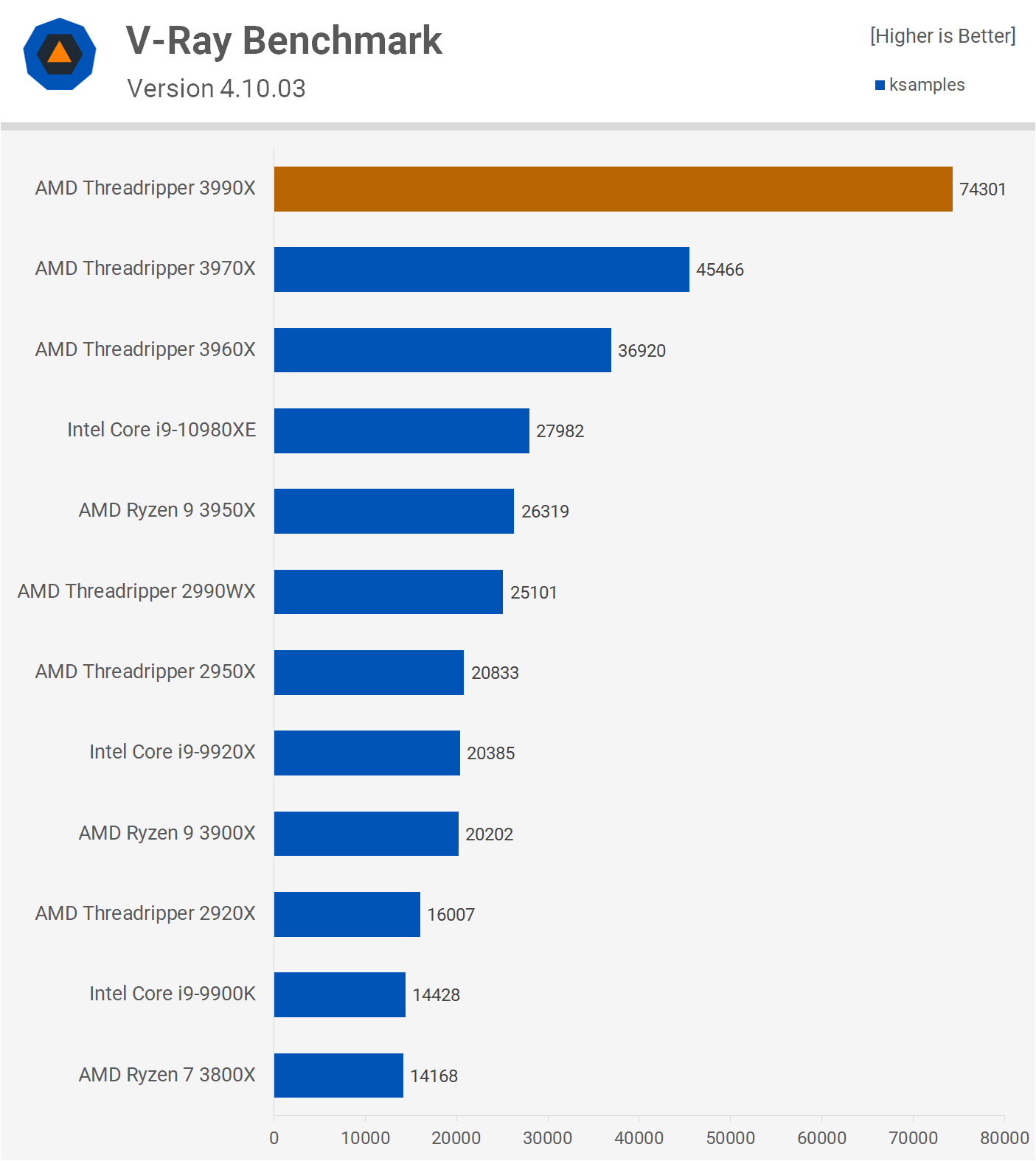
The 3990X simply dominates in V-Ray, even more so than it did in Cinebench. This time beating the 32-core 3970X by a 63% margin and that meant it was 165% faster than the 10980XE. What more can you say, for these rendering applications the 3990X is everything AMD promised it would be.
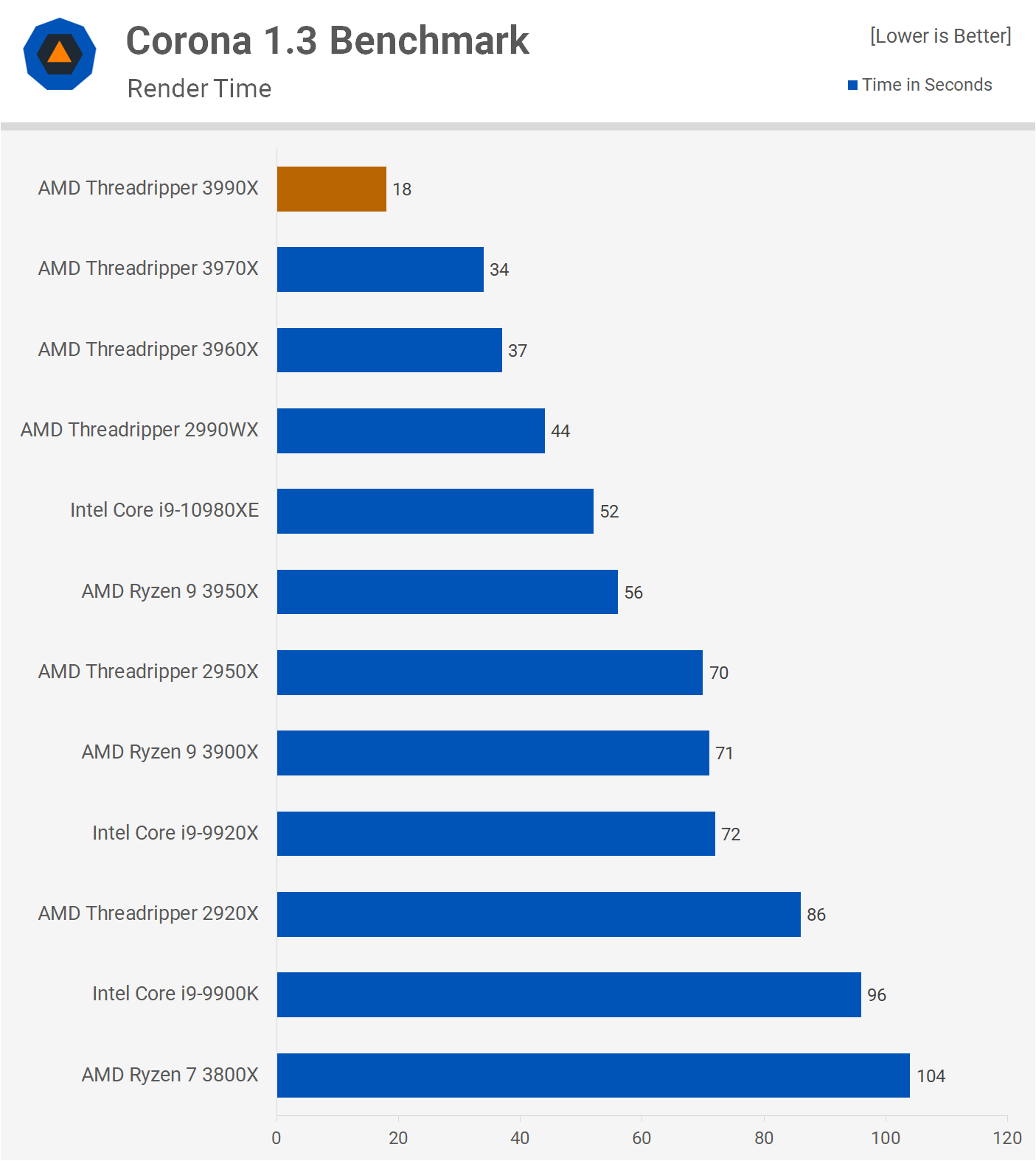
The Corona benchmark which takes almost 2 minutes with something like the Ryzen 7 3800X, took a mere 18 seconds using the Threadripper 3990X. The 64-core processor took 47% less time to complete the test when compared to the powerful 3970X.

The Threadripper 3990X completed the Blender Open Data benchmark in just under 3 minutes which is insane.
This test has traditionally taken quite some time to complete, even with previous HEDT parts. For example, the 2990WX did really well here, yet it took a little over 6 minutes to complete whereas Intel's Core i9-10980XE took roughly 9 minutes... this means the 3990X is a little over 3x faster.
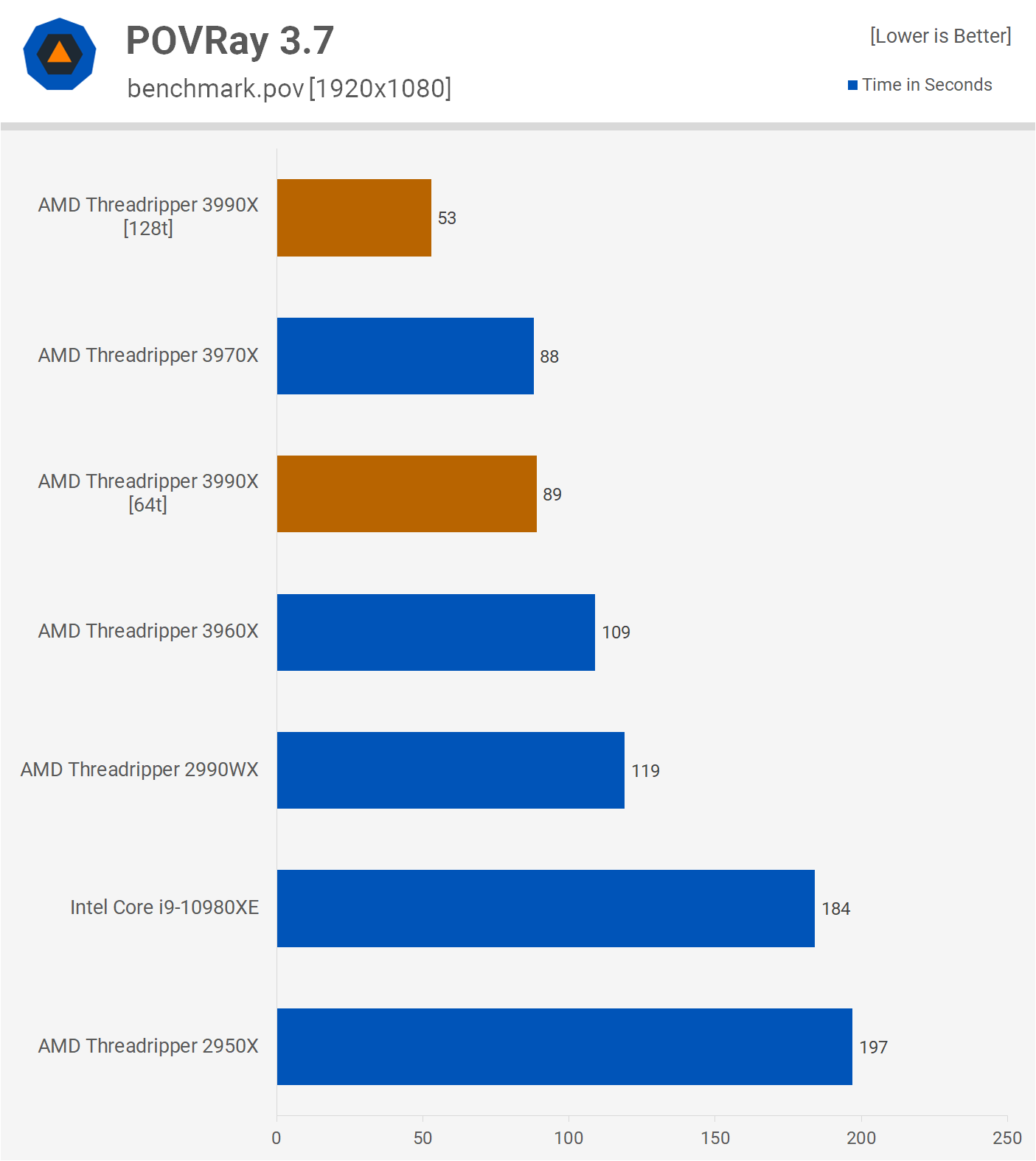
POVRay was a last minute addition to this review. We added it because it's a good example of a program that supports up to 64 threads, at least the current public release does. AMD has submitted updated code that allows POVRay to scale beyond 64 threads and fully utilize the 3990X.
Here we can see with the current 64-thread limit the 3990X is only able to match the 3970X, but with the update which should be publicly available soon, the 64-core processor will receive an almost 70% performance boost.
Power Consumption

We know all 3rd-gen Threadripper parts feature a 280w TDP, so power consumption should be similar, and it is. Due to a binning process and a reduction in clock speeds/voltages the 3990X doesn't consume much more power than the 32-core version, pushing total system usage just 3% higher, which is remarkable given we often saw well over a 50% increase in performance when fully utilized.
Gaming Benchmarks
Gaming on the 3990X is kind of dumb... at least dedicated gaming totally is. And yet many of you will at least want to know how the CPU behaves in gaming tasks. In the name of science, we've run our usual batch of games and we'll just blast through those results now. We won't spend much time on analysis because it's a little silly, but who knows the guys making the visual effects for Terminator might have wanted to play the Terminator game on their high-end workstations when they weren't rendering, we're sure at some point that was a thing.
Anyway, the performance in Battlefield V was great...
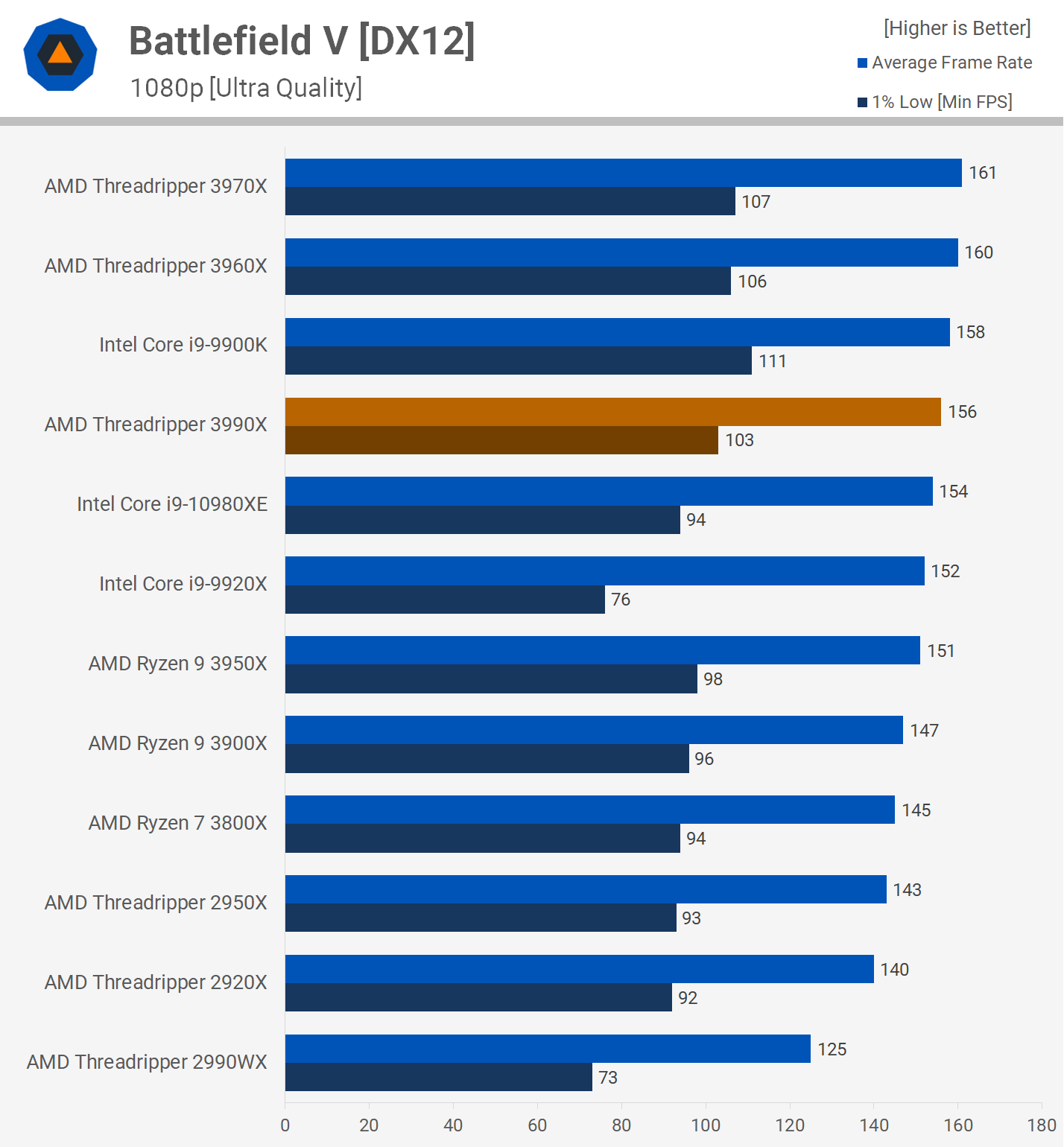

Shadow of the Tomb Raider also played exceptionally well. You're looking at a similar experience to that of the 10980XE.
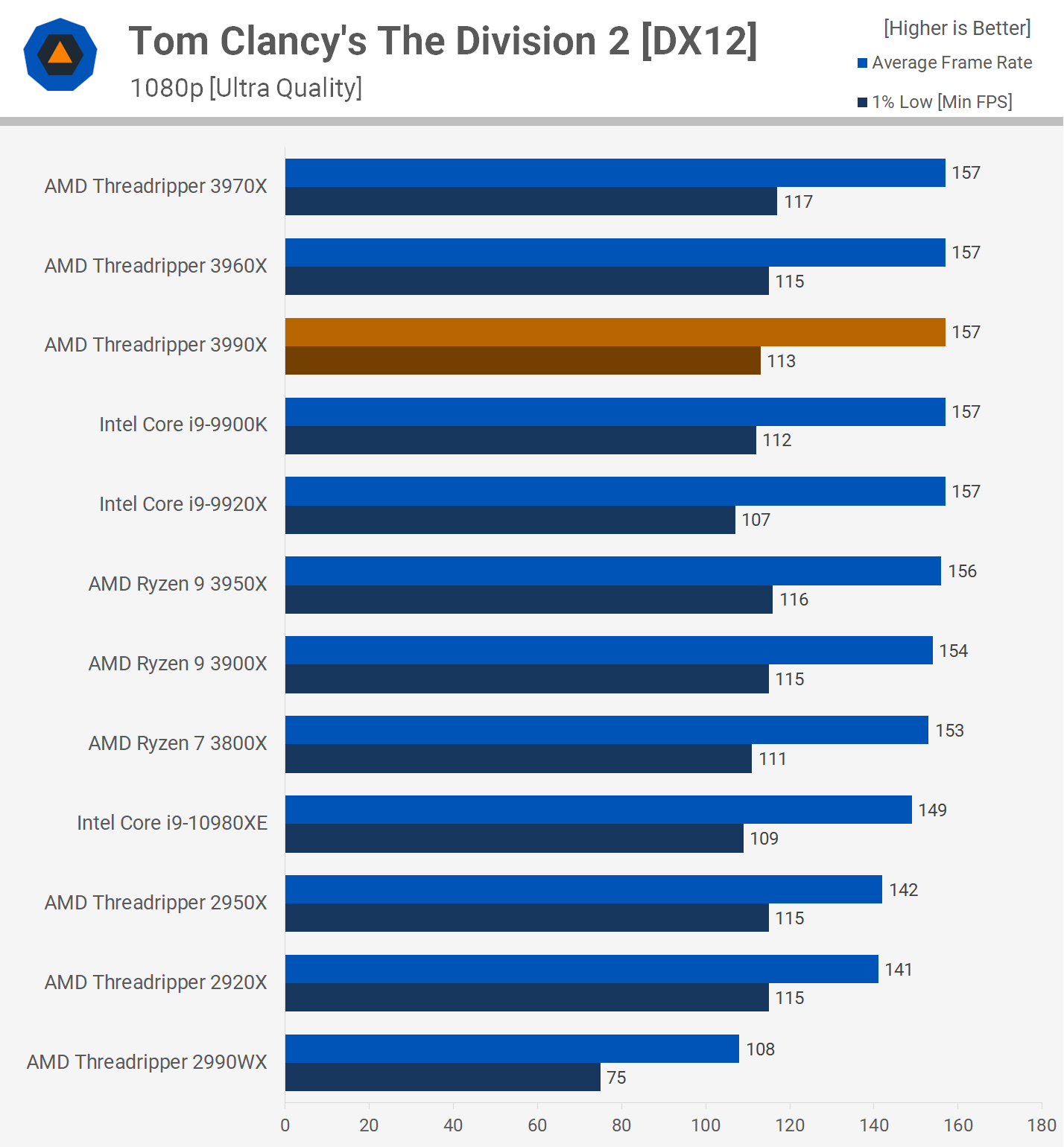
Tom Clancy's The Division 2... that also worked, performance was as expected.
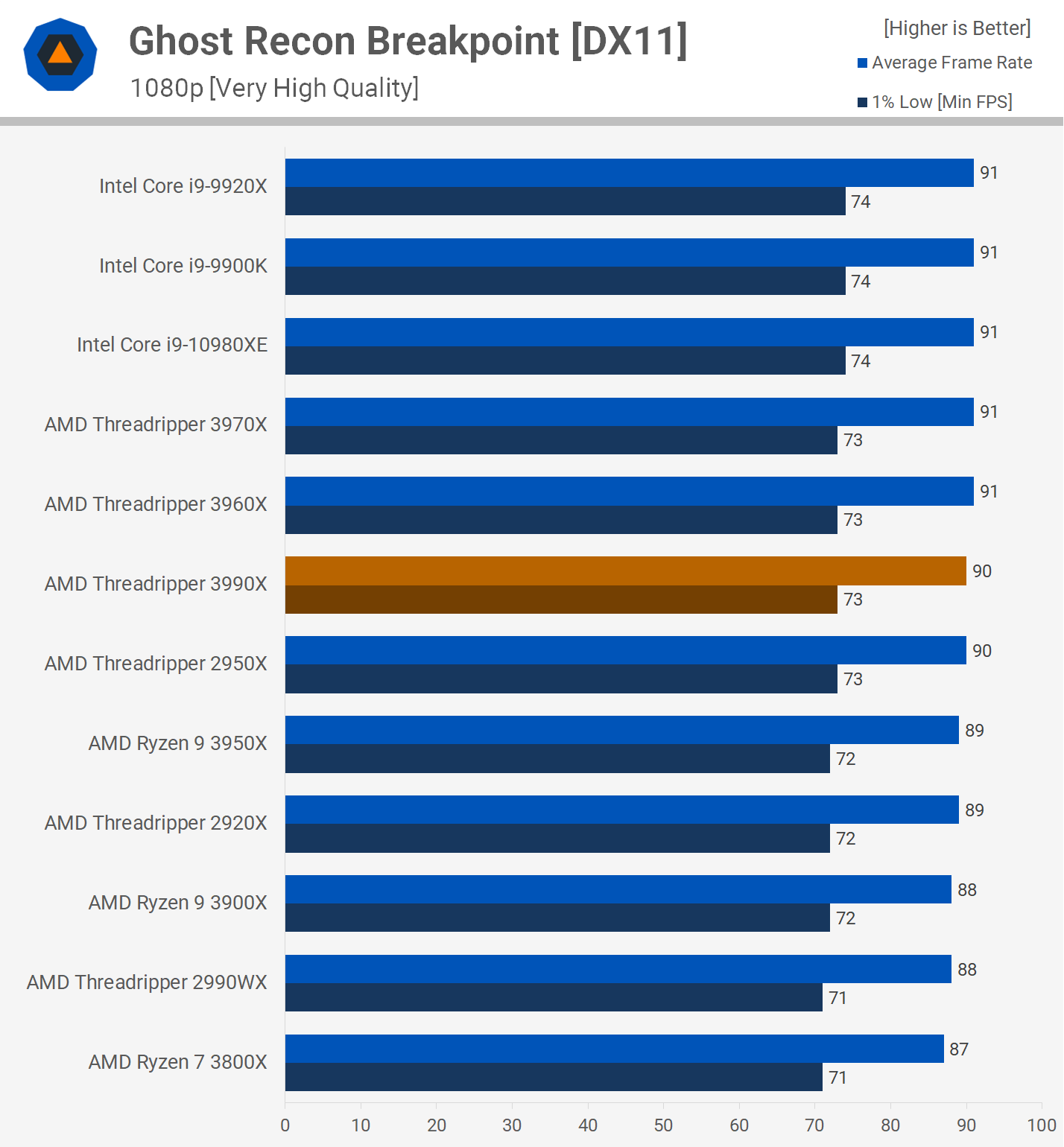
Tom Clancy's Ghost Recon Breakpoint was like, this is more CPU than I need, enjoy the GPU bottleneck.

F1 2019 appreciated the advanced technology and the Silver Arrows seemed to perform even better than usual, hmm wonder what's going on there.
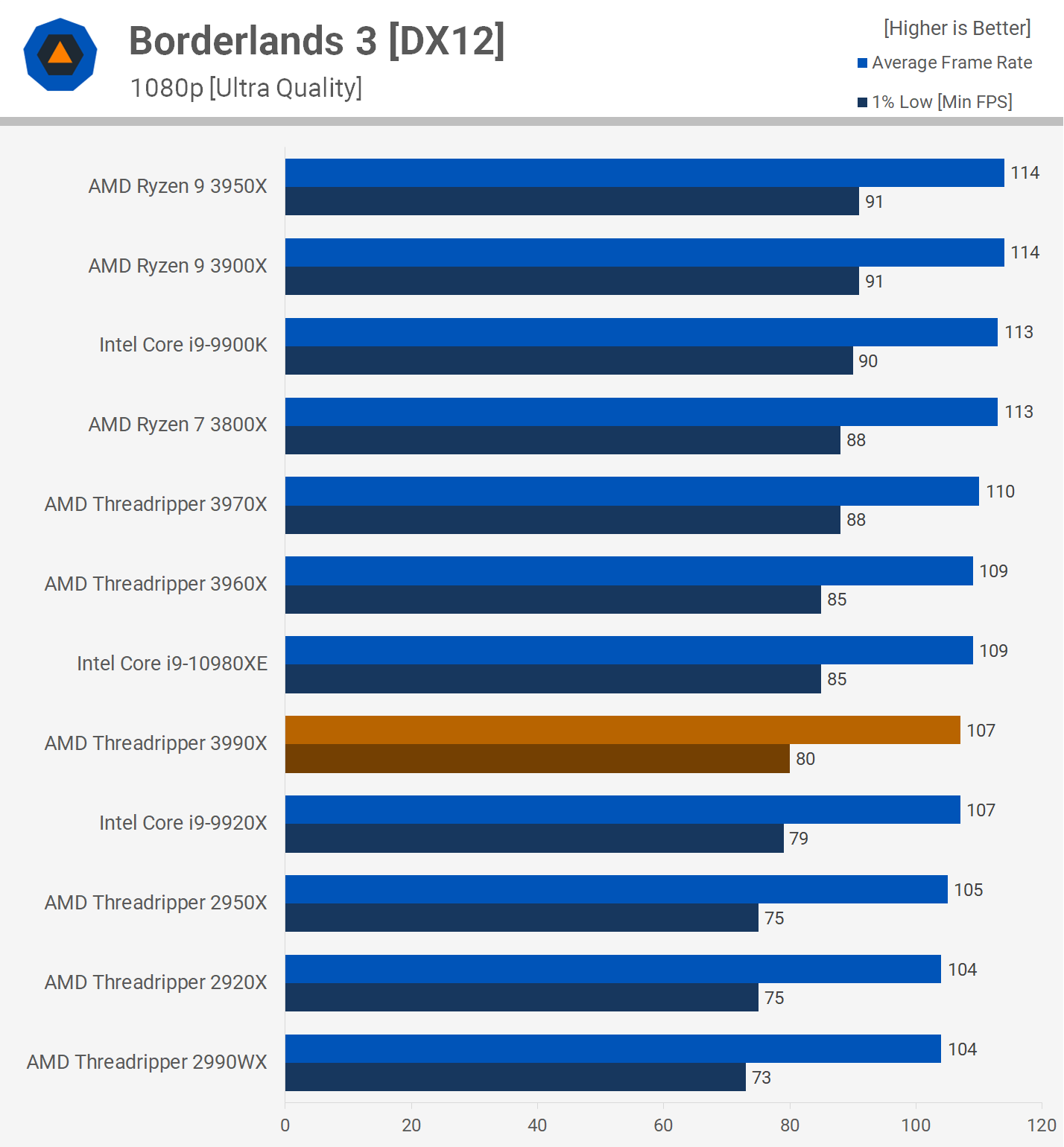
Borderlands 3 also... worked and it worked well.
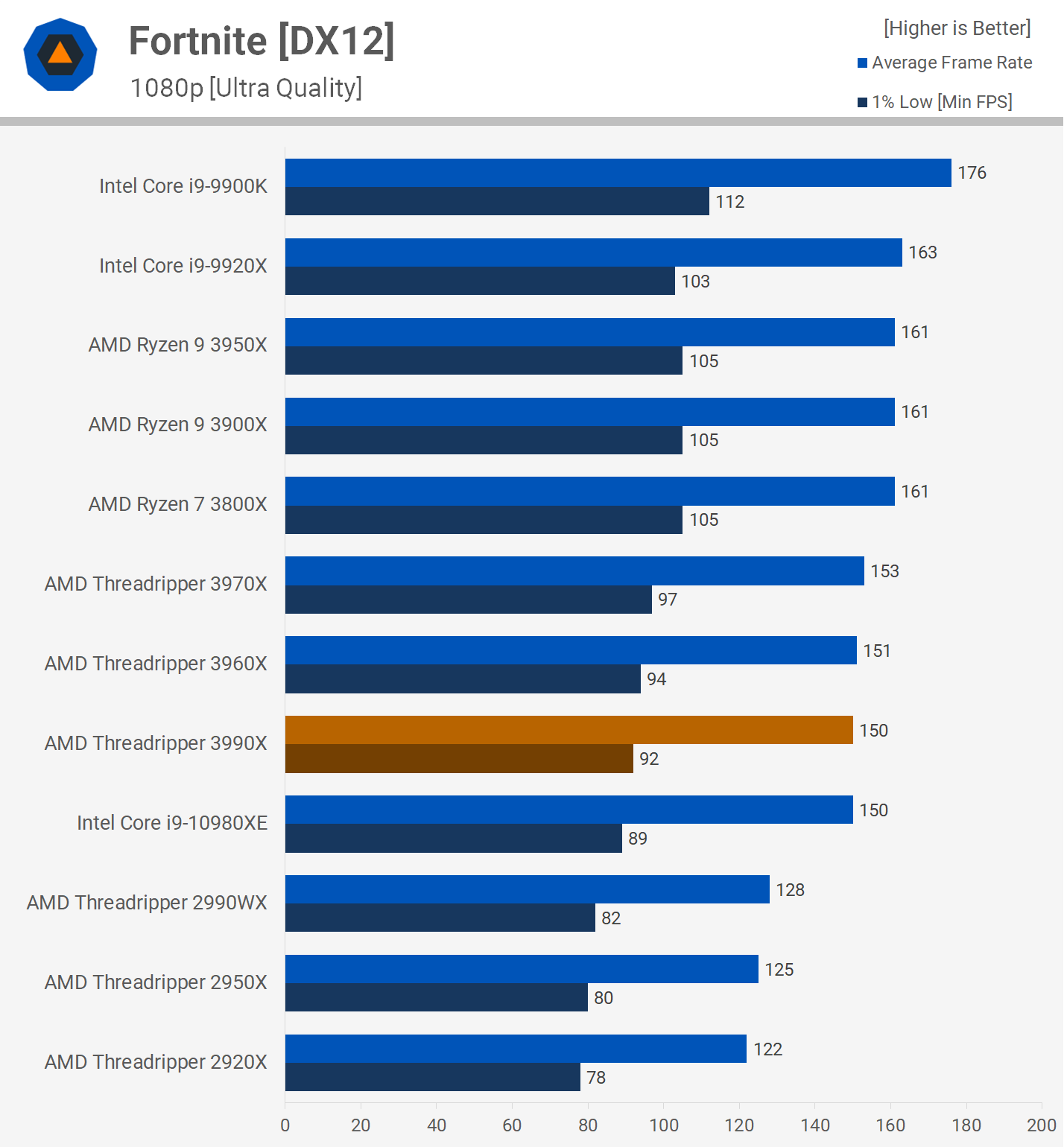
We really hope this is the first and last 128-thread Fortnite benchmark. Good times.
Overclocking
We fully expect pro overclockers to have a seriously fun time with the 3990X. For this 3.7 GHz all-core overclock we applied just 1.2v and that was enough to see the total system draw hit 765 watts with a CPU temp of 77 degrees.
Oddly, when messing around we managed to boot into Windows with all cores clocked at 4 GHz and this produced a score of just over 30,000 pts on Cinebench R20. The CPU peaked at 92 C and the total system load just exceeded 850 watts. Annoyingly, we achieved this in the early hours of the morning, we don't recall the exact settings used and with very little time to replicate it during the few days we had for testing, we ran out of time.

Using just 1.2v, 3.7 GHz was the best we could achieve while properly collecting all the data. This led to a 14% increase in performance and meant the overclocked 3990X was still 54% faster than the overclocked 3970X at 4.2 GHz.
For measuring thermal performance we ran an hour long Blender stress test in a 21 C room using a range of cooling devices. Basically we ended up with the same results as the 3970X, which isn't hugely surprising given power consumption was similar. Basically each CCD will be drawing less power and therefore generating less heat, but there are twice as many of them so you end up with a similar outcome. The good news being out of the box the 3990X isn't difficult to keep cool.
What We Learned
The Threadripper 3990X is a beast, it's completely unchallenged and redefines the HEDT space. Right now nothing comes close to offering the same level of performance, and we were relieved to find that the 3990X has no real weakness.
When under-utilized, performance is still strong and comparable to that of lower core count parts. Like the 2990WX before it, the TR 3990X is a superstar for rendering tasks, but unlike the 2990WX, it still performs well when not fully utilized or faced with memory or latency-sensitive workloads. This was a major issue with the 2990WX as you didn't really know if it was going to be a beast or a bot for your workload. It was crucial to have your exact workload tested before buying and that's not always an option. With the 3990X though, it's a much safer purchase, basically if your application can use the cores, the 3990X will deliver the goods.
At this point you might be wondering where are our usual price vs. performance graphs, but for this one we decided not to bother. The 3990X is not about price-to-performance, rather the idea here is to offer the absolute best performance period for core-heavy workloads. It's a little bit like how we only recommend the Core i9-9900K for gamers with extreme setups consisting of an RTX 2080 Ti, for example. And it's also a bit like how we only recommend the RTX 2080 Ti for extreme 4K gaming with expensive high-end monitors.
The Threadripper 3990X brings a significant jump, more so than either the 9900K or 2080 Ti, as it's not just a little bit faster than the next best thing, it's a lot faster.
Now we've talked a bit about who AMD's targeting with this massive 64-core processor: professional visual effects artists, for example, but it's not just VFX guys that the 3990X is designed for. It's VFX guys that have projects that take 1 or 2 days to render using a more traditional HEDT part. For example, where the 2990WX might take 24 hours complete a render, the 3990X could reduce the completion time of the same job to just 15 hours.
Saving that kind of time per project is worth paying the 3990X's asking price. On the other hand, for those with projects that take mere hours to render, AMD recommends checking out the TR 3960X or 3970X as they're going to be more appropriate for such workloads.
In my personal case, I'd would look at purchasing either the 3960X or 3970X for the content creation work I do. Right now I'm using the 3960X and I have to say, it's amazing. Before this I used the Threadripper 2950X and then for a brief 2-month period, before transitioning to 3rd-gen Threadripper, I tried out the Core i9-9900K in Premiere. The upgrade from the 9900K to the 3960X was significant, and while Threadripper is significantly more costly, it also allows me to do much more.
For example with the Core i9, I could apply the warp stabilizer effect to about 6-8 b-roll clips simultaneously. Any more and the system would slow to a crawl and often crash. With the 3960X I can warp stabilize all the b-roll in a 10-15 minute video, about 20-30 clips at the same time, and still create a thumbnail in Photoshop without noticing any slow down. It's phenomenal and has massively speeded up my workflow.
We see the Threadripper 3990X doing much the same for visual effects artists, software developers compiling projects, and anyone else who can make use of a 64-core processor.
Overall an incredible product from AMD that is not only exciting for professionals today, but it paves the way for more affordable core-heavy desktop parts in the near future.
Shopping Shortcuts:
- AMD Threadripper 3990X on Amazon
- AMD Threadripper 3970X on Amazon
- AMD Threadripper 3960X on Amazon
- AMD Ryzen 9 3950X on Amazon
- AMD Ryzen 7 3700X on Amazon
Further Testing
Since we published this review, we have run additional benchmarks and comparisons you may be interested in:
